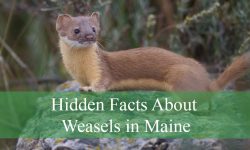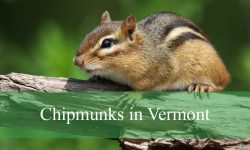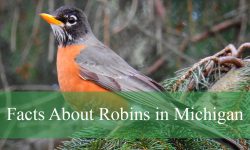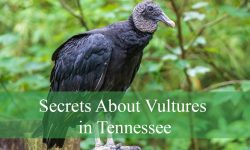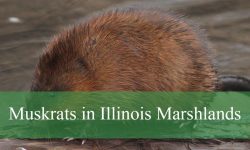The term “yellow and black stripe bug” encompasses a variety of insects known for their distinctive coloration and striking patterns. These bugs, ranging from beetles to wasps, are often recognized by their vivid yellow and black stripes, which serve various purposes such as warning predators, camouflage, or attracting mates.
Their bold markings not only make them stand out in their natural habitats but also play crucial roles in their survival and ecological interactions.
The following article will explore 39 species of yellow and black stripe bugs and how to identify them across North America.
Different Types of Yellow and Black Stripe Bugs
Cicada Killer

Cicada Killer Wasps, such as the Eastern Cicada-killer Wasp (Sphecius speciosus), are large wasps with black, yellow, and red-brown coloring. They are the largest wasps in Eastern North America, growing up to 2 inches in length. Though less aggressive towards humans, they can still sting if provoked.
These ground-nesting wasps are known for their cicada-based predatory behavior, paralyzing cicadas and bringing them back to their nests as food for their larvae. Cicada Killer Wasps are commonly found in the Midwest and Eastern United States, Central America, and the Caribbean.
Spotted Cucumber Beetle
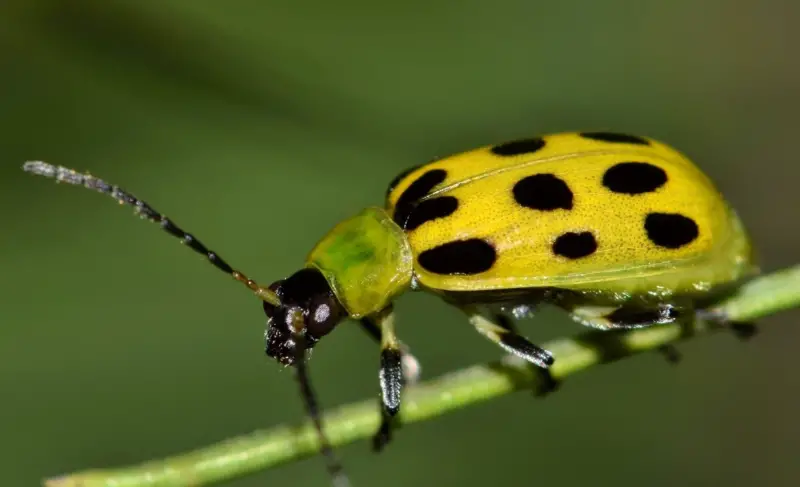
Spotted Cucumber Beetles (Diabrotica undecimpunctata) are notorious pests, particularly for crops like cantaloupe and cucumber in Florida. These beetles feature yellow and black coloring, with varying black patterns ranging from spots to bands. Widely distributed across the United States, they are especially prevalent in the Southern states due to their migratory nature, leaving the North during winter.
Their ability to multiply rapidly stems from their larvae developing in the ground, free from many natural predators. Spotted Cucumber Beetles are found across Canada, the United States, and Mexico.
Locust Borer
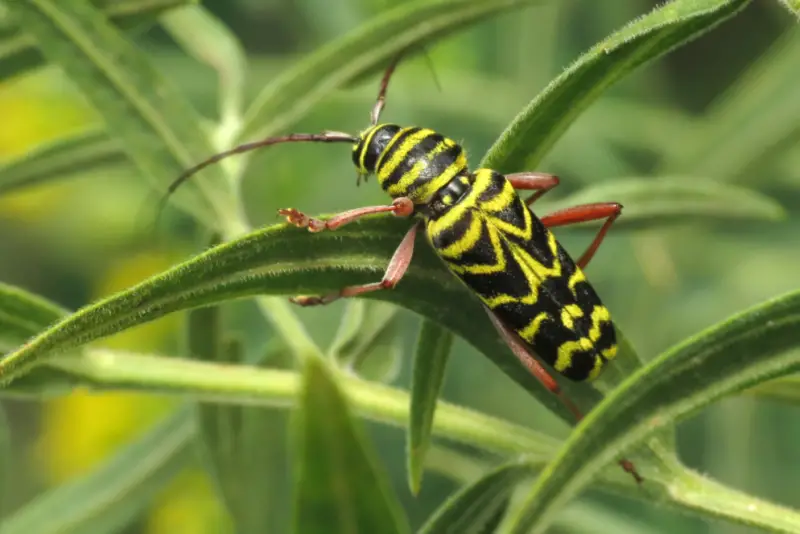
Locust Borers (Megacyllene robiniae) are distinctive black and yellow beetles known for their striking pattern of yellow stripes on a black base. These stripes create a wavy pattern on the wings and straight lines on the thorax and head, while their long antennae are also adorned with yellow and black bands.
Commonly found on black locust trees and goldenrod, Locust Borers are native to North America, particularly from Pennsylvania to Georgia, with sporadic occurrences outside this range. Their populations struggle to establish outside their native habitat.
Fourteen-spotted Lady Beetle
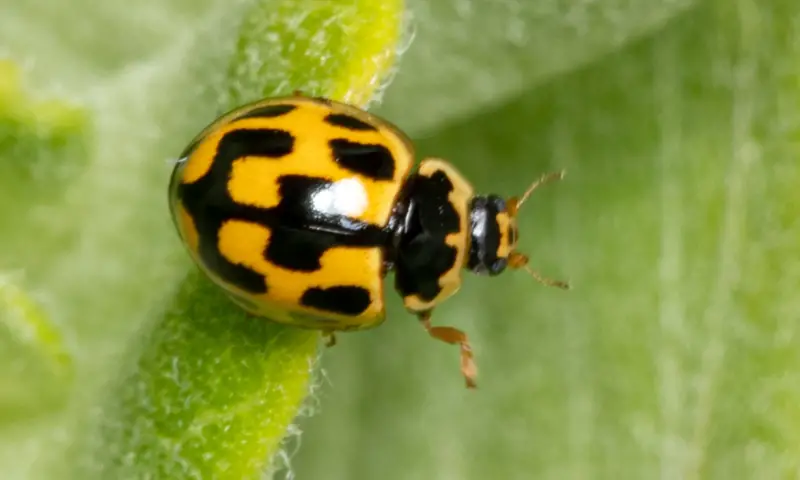
Fourteen-spotted Lady Beetles (Propylea quatuordecimpunctata) are named for the 14 spots that adorn their elytra and cephalothorax. These beetles exhibit color variations, with some being bright yellow with black spots, while others are darker, featuring a black base with red, orange, or yellow spots.
In their larval stage, they are a mix of brown, black, and yellow. Native to Europe and North Africa, these beetles are recognized for their distinctive spotted appearance.
Ornate Checkered Beetle
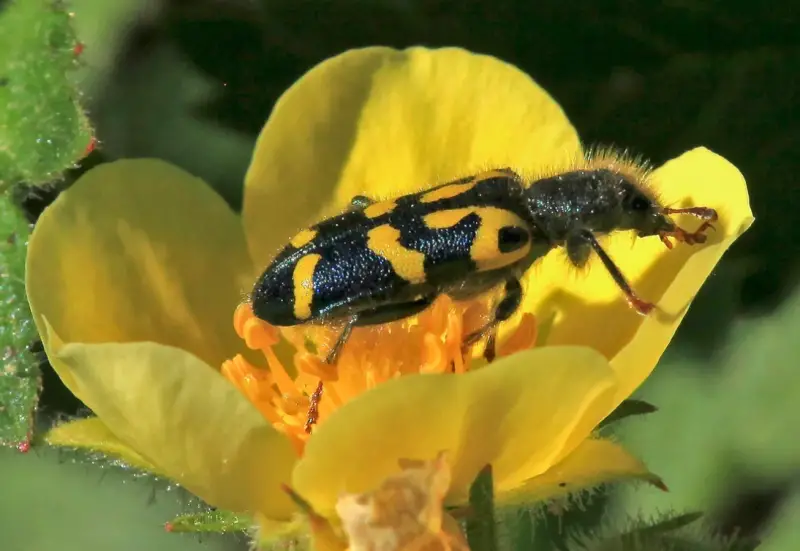
The Ornate Checkered Beetle (Trichodes ornatus) often resembles the flowers it frequents. Predominantly black, some individuals may appear blue-black with vibrant patterns on their elytra. Distinctive yellow, red, and orange wavy patterns decorate these beetles.
They are commonly found on buckwheat and common yarrow, where they contribute to plant pollination. With a short lifespan, Ornate Checkered Beetles lay their eggs on their host flowers. They are native to North America.
Striped Cucumber Beetle
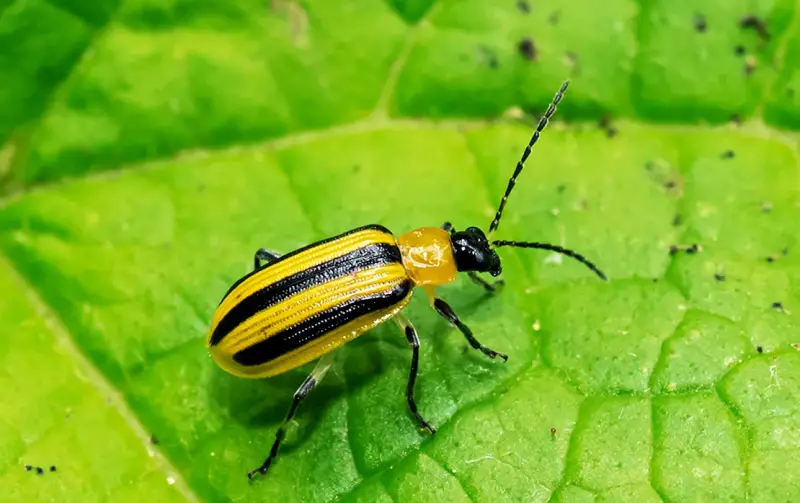
The Striped Cucumber Beetle (Acalymma vittatum) is characterized by its black, yellow, and pale yellow coloration. Typically pale yellow with black stripes along its wings, this beetle also features a golden yellow and black cephalothorax. There is a dark morph as well, which is predominantly black with yellow stripes.
A significant pest in Eastern North America, Striped Cucumber Beetles damage cucumbers and pumpkins by feeding on their leaves and spreading disease-causing bacteria. They can survive winters in the ground or among ground-level vegetation. They are found east of the Rocky Mountains.
Pigweed Flea Beetle
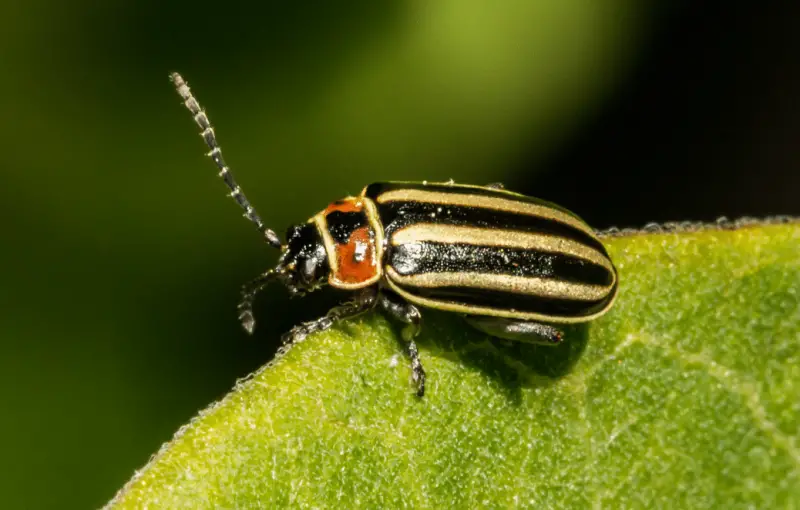
Pigweed Flea Beetles (Disonycha glabrata) are primarily yellow and black with some brown hues, and they are known for feeding on amaranth. They have a black main color on their elytra adorned with four distinctive golden-yellow stripes arranged in pairs, connecting at the tips of their wings.
Additionally, small black dots can be seen on their cephalothorax. Found across North America, Pigweed Flea Beetles are easily identifiable by their unique striping pattern.
Colorado Potato Beetle
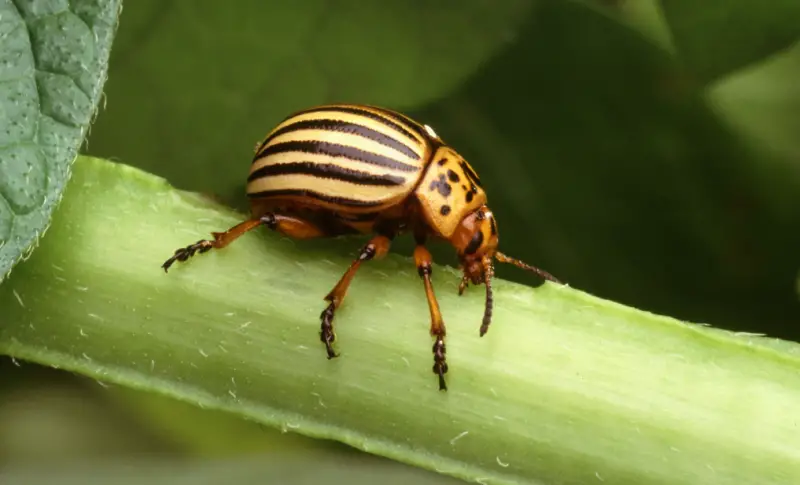
The Colorado Potato Beetle (Leptinotarsa decemlineata) is a significant pest of potatoes, ranking among the most important agricultural bugs globally. Originating from its initial spread on potato plants, it has become a major threat to potato crops. The beetle begins its life as a yellow egg, then transitions through red juvenile stages before becoming an adult with a distinctive yellow and black appearance.
Its contrasting black stripes and brown and black cephalothorax make it easily recognizable. Colorado Potato Beetles are found in North America, Europe, and Asia.
Three-lined Potato Beetle
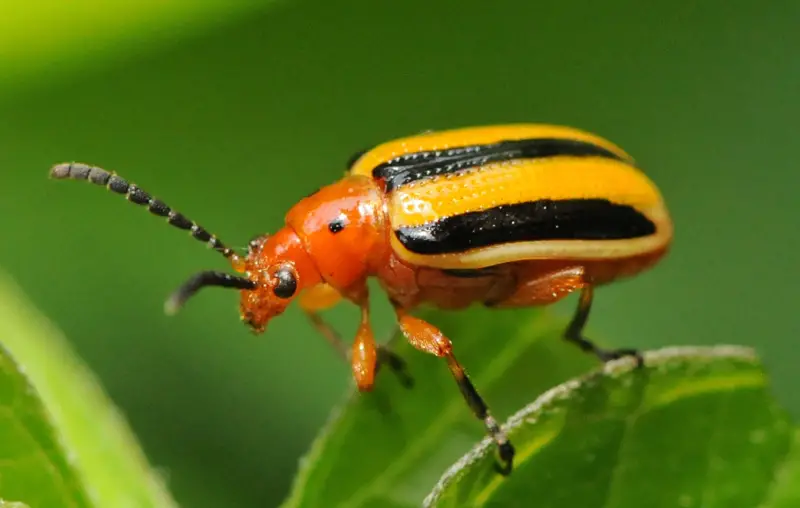
The Three-lined Potato Beetle (Lema daturaphila) is another notable pest of potatoes, similar to the Colorado Potato Beetle. These beetles are often managed by hand-picking on a small scale, while chemical treatments are used for adults. They are characterized by their yellow or pale yellow elytra, which may sometimes appear golden.
A contrasting black stripe runs along their wings, and their brown and black prothorax adds to their distinctive appearance. Three-lined Potato Beetles typically appear later in the season, starting in August, and are found in North America and Central America.
Zebra Longhorn Beetle
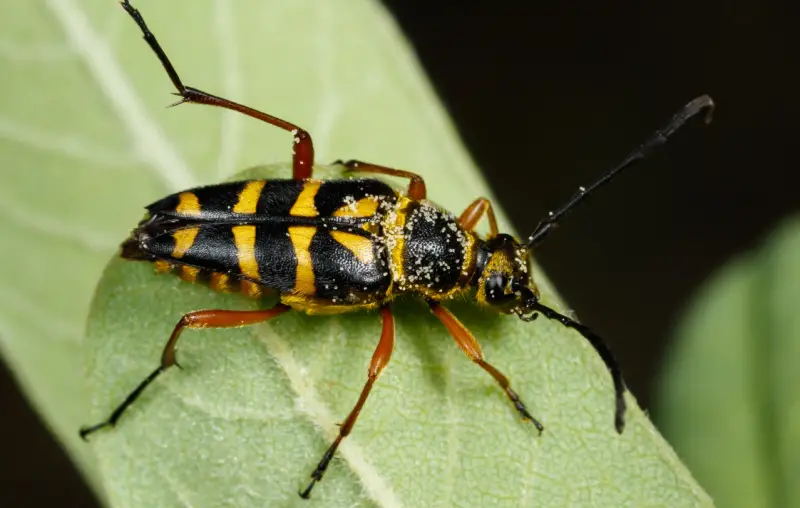
The Zebra Longhorn Beetle (Typocerus zebra) is named for its distinctive yellow and black striped appearance. With a black base color across all morphs, its dorsal side is adorned with contrasting yellow stripes, though some variants may feature dots instead of full bands.
This elongated beetle is commonly found around decaying wood and on various types of flowers. It is native to North America.
Squash Lady Beetle
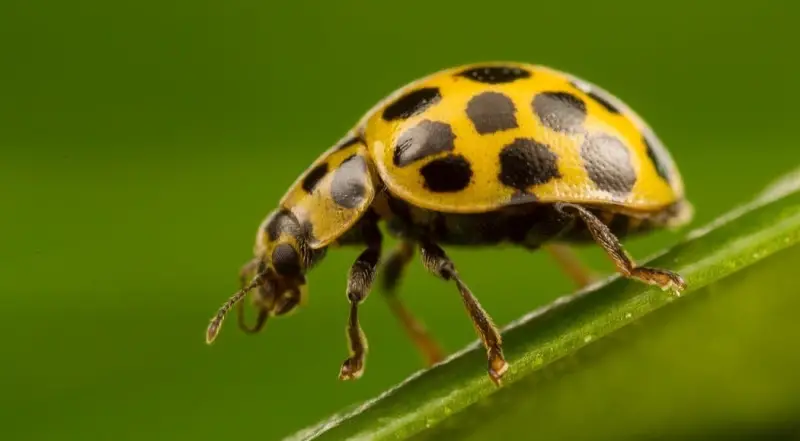
Squash Lady Beetles (Epilachna borealis) are distinguished by seven black spots on their varying colored bodies, which can be black, red, or red-brown. All morphs feature contrasting black dots.
These beetles are particularly damaging to squash and pumpkins, as they are skeletonized-feeding insects, consuming the soft parts of leaves and significantly impeding plant growth and development. They are commonly found in North America.
Eastern Elderberry Borer
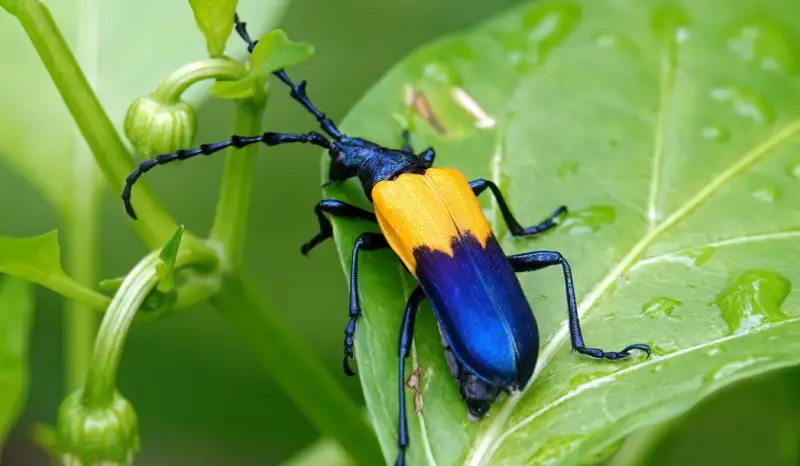
The Eastern Elderberry Borer (Desmocerus palliatus) is a pest primarily affecting elderberry plants in Eastern North America. This beetle is mostly black with distinctive yellow patches at the base of its wings, though brown and black morphs are also common.
The Eastern Elderberry Borer causes significant damage by boring into plant stems to lay its eggs. Its presence can severely impact the health of elderberry plants.
Harlequin Flower Beetle
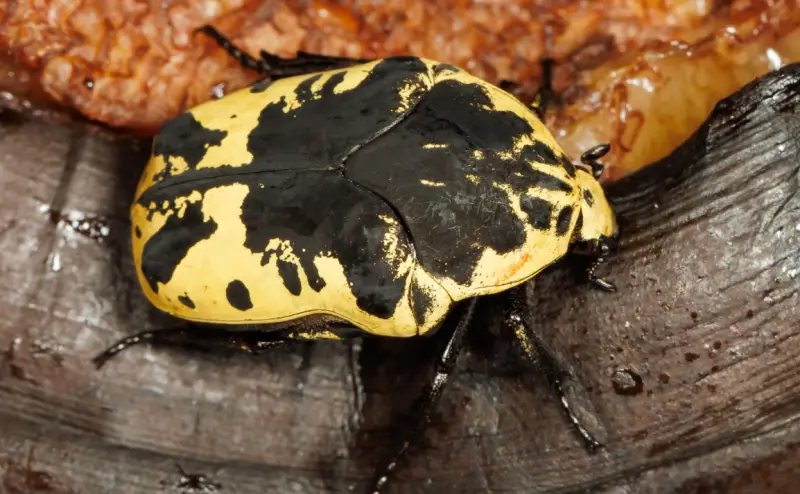
Harlequin Flower Beetles (Gymnetis thula) are vibrant scarab beetles often found on trees and flowers. They exhibit a range of color morphs, with yellow and black, yellow and brown, as well as cream and black or cream and brown variants. These beetles, which can grow up to 0.8 inches in size, have a rounded shape and dual-colored appearance.
They feed on flowers and fruit. Their range includes parts of the Eastern and Southeastern United States, and the Gulf of Mexico, though they may be sporadically present in these areas.
Four-lined Plant Bug
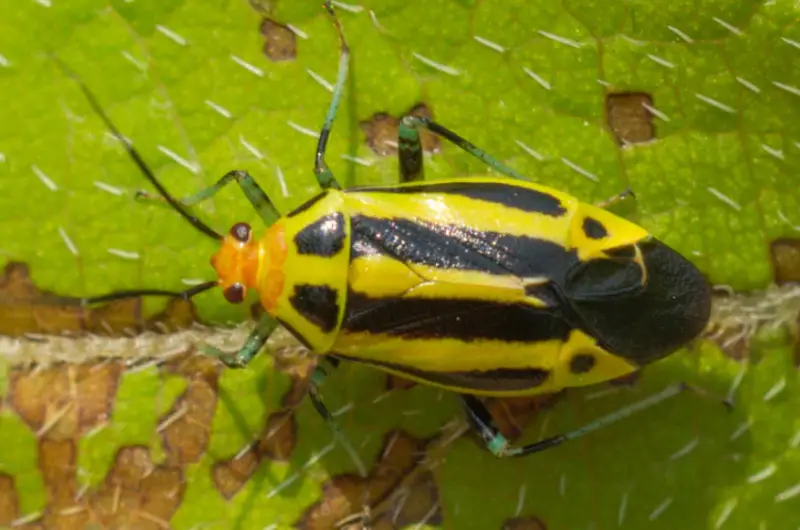
Four-lined Plant Bugs (Poecilocapsus lineatus) are elongated, shield-shaped insects known for their distinctive yellow stripes on black wings. Their prothorax also features black and yellow coloring, with a red tip on the head. Some rare morphs may appear black with green stripes.
These bugs are plant feeders that damage plants in the mint family, with both adults and larvae feeding on mint leaves, and eggs laid directly in the plant stems. They are found in the United States and Canada.
Two-spotted Grass Bug
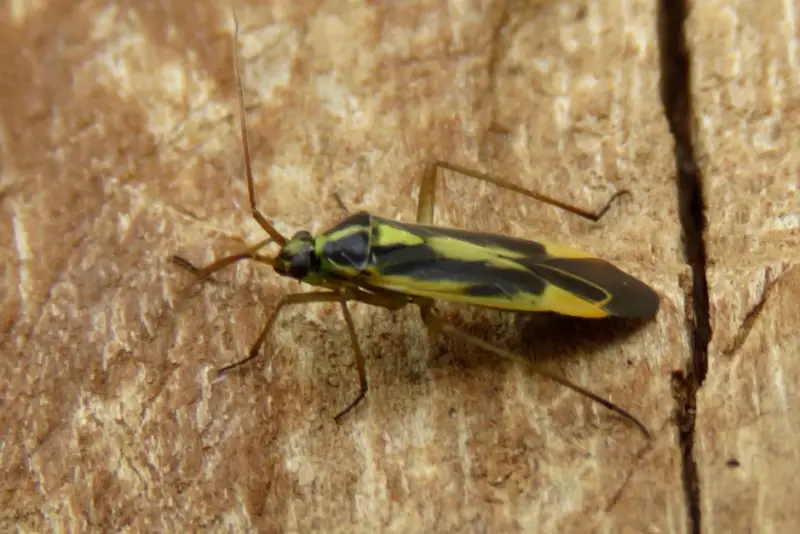
Two-spotted Grass Bugs (Stenotus binotatus) are unique in that males and females exhibit different colorations. Males are characterized by their black and yellow colors, featuring a wave-shaped pattern of yellow marks on their elongated wings, and black and yellow legs and antennae.
In contrast, females are mostly green with decorative black patches. These bugs feed on various types of grass and are found in North America, Europe, Asia, and Oceania.
Harlequin Bug
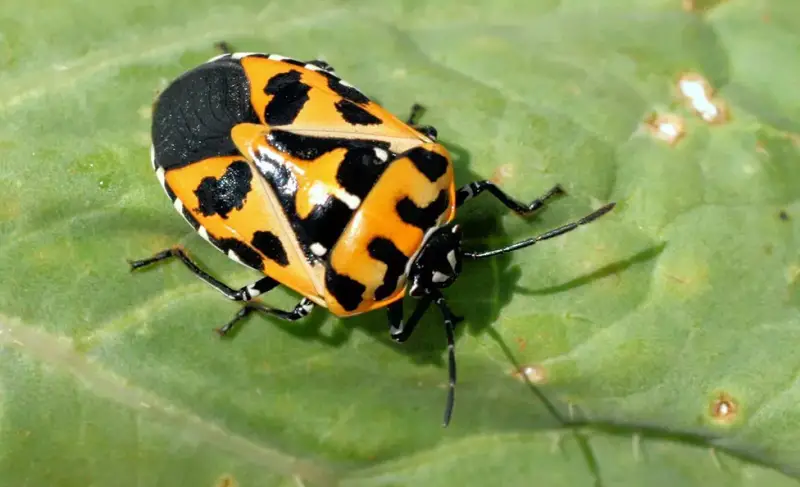
Harlequin Bugs (Murgantia histrionica) are characterized by their dominant black and yellow colors, with some variants displaying yellow-orange hues. They start life as black and yellow-orange nymphs, gradually maturing into black and yellow-orange adults, often losing their white markings over time.
These bugs are significant pests, causing extensive damage to crops such as cauliflower and Brussels sprouts if not managed properly. They are particularly problematic as they emerge in early spring. Harlequin Bugs are found in the United States and Mexico.
Saddled Leafhopper
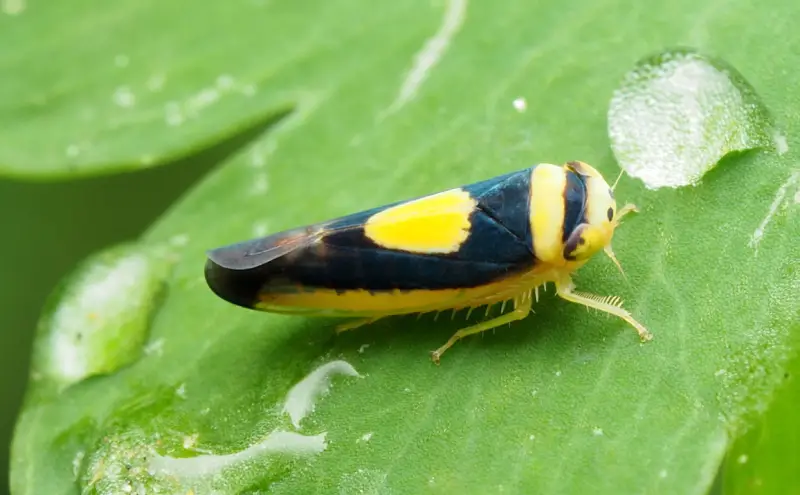
Saddled Leafhoppers (Colladonus clitellarius) are among the smallest yellow and black bugs in North America, feeding on soft plants and tree leaves. They feature predominantly black wings with a central yellow dot, and their heads also display a mix of yellow and black.
These tiny bugs, growing up to 0.2 inches, may also appear in brown and yellow variations. Both color morphs have an all-yellow ventral side. Saddled Leafhoppers are found east of the Rocky Mountains.
Dogwood Spittlebug
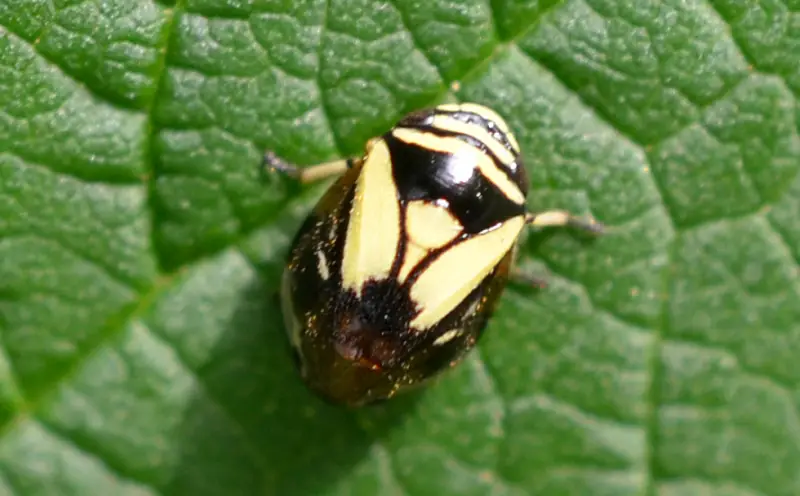
Dogwood Spittlebugs (Clastoptera proteus) are primarily black and yellow, with variations including a black or brown head. These small, round bugs grow up to 0.3 inches and are known for their jumping behavior.
They are commonly found on dogwood trees, where the nymphs suck sap, while adults may feed on dogwood and other tree leaves. Nymphs appear from May onwards, but their eggs are difficult to spot as they are laid under tree bark. Dogwood Spittlebugs are found from Maine to North Carolina.
Brown Marmorated Stink Bug
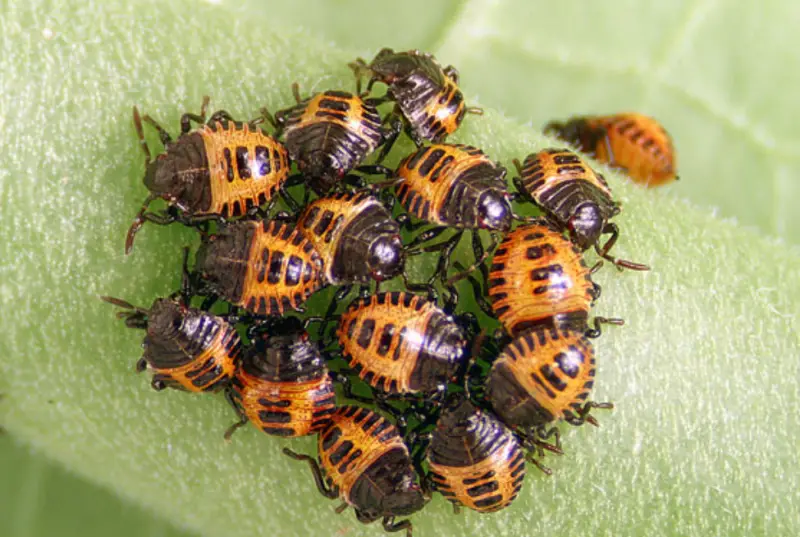
Brown Marmorated Stink Bugs (Halyomorpha halys) are large and numerous pests that pose significant challenges for managing crops across Eastern North America. These shield-shaped bugs are brown as adults and can invade various crops and tree plantations.
In their nymph stage, they are black and yellow, featuring a round shape with a yellow dorsal pattern and additional black marks. Brown Marmorated Stink Bugs are found both east and west of the Rocky Mountains.
Hoverflies
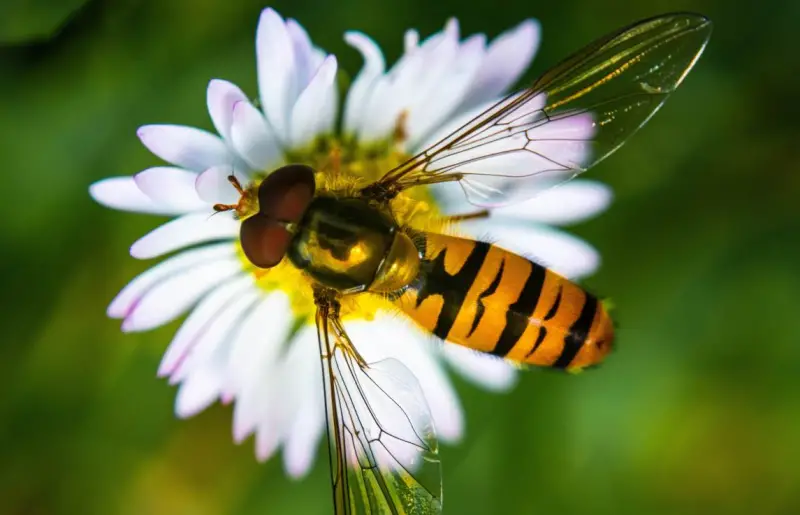
Hoverflies, known for their diverse shapes and sizes, often feature black and yellow coloration. Species like Criorhina floccose and Criorhina ranunculi are examples of hoverflies with this coloring. They have hairy bodies and primarily feed on plant pollen, while their larvae may consume decaying plant matter.
Hoverflies are commonly found around woodlands, especially oak and birch woodlands. Adults can mimic other black and yellow insects, such as bumblebees, to visit the same flowering plants. They are distributed across Europe, North America, and Asia.
Golden-backed Snipe Fly
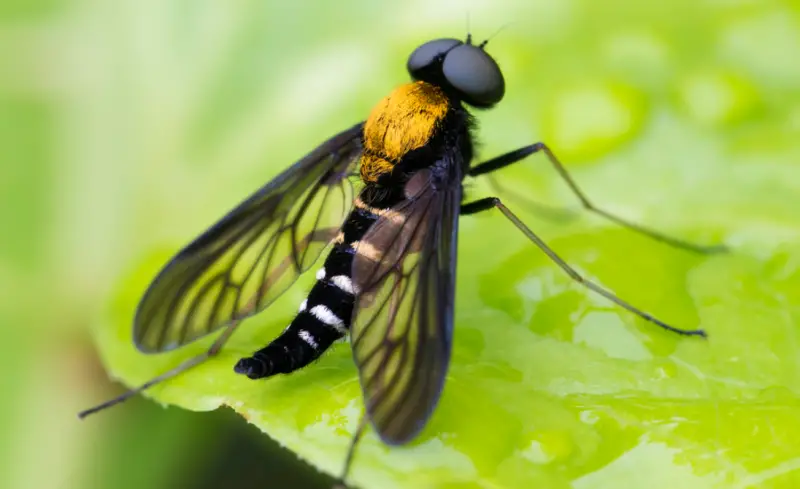
Golden-backed Snipe Flies (Chrysopilus thoracicus) are relatively unknown despite their abundance in the United States. Native to North America, these yellow and black flies live secretive lives in woodlands.
They have long black bodies adorned with yellow markings and transparent wings with black veins. Feeding on other insects, Golden-backed Snipe Flies can be observed in woodlands during early summer. They are primarily found in the Eastern US woodlands.
Striped Deer Fly
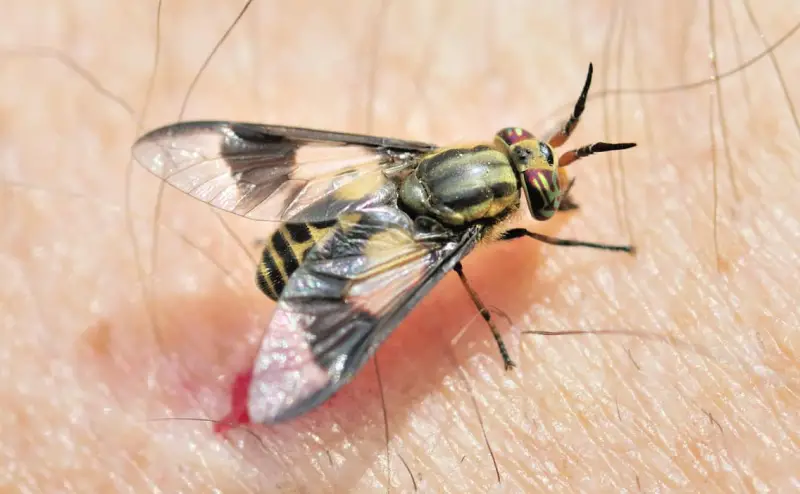
Striped Deer Flies (Chrysops vittatus) are named for their distinctive striped dorsum, which features varying patterns of black and yellow stripes. Some individuals are predominantly yellow with black stripes, while others are mainly black with yellow stripes.
These large flies are known for their painful bites, as they require blood for reproduction and may bite humans or animals. They are preyed upon by other black and yellow insects like wasps. Striped Deer Flies are found throughout North America.
Black-and-gold Flat Millipede
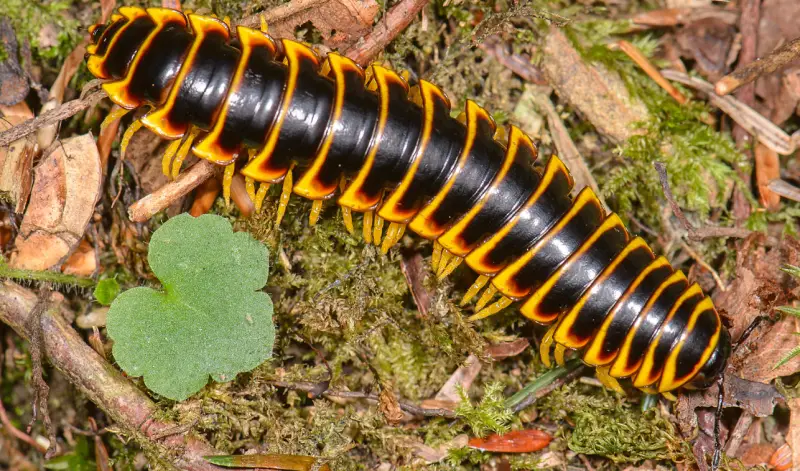
The Black-and-gold Flat Millipede (Apheloria virginiensis) features a black dorsum with yellow-orange bands and yellow legs. It thrives in parks and woodlands rich in litter, feeding on decaying leaves and mulch.
Growing up to 2 inches, this millipede can roll up for defense or release a potent chemical. It is also known to be poisonous, causing skin irritation upon contact, so handling it is not recommended. This species is found in North American forests.
Bumblebee Millipede
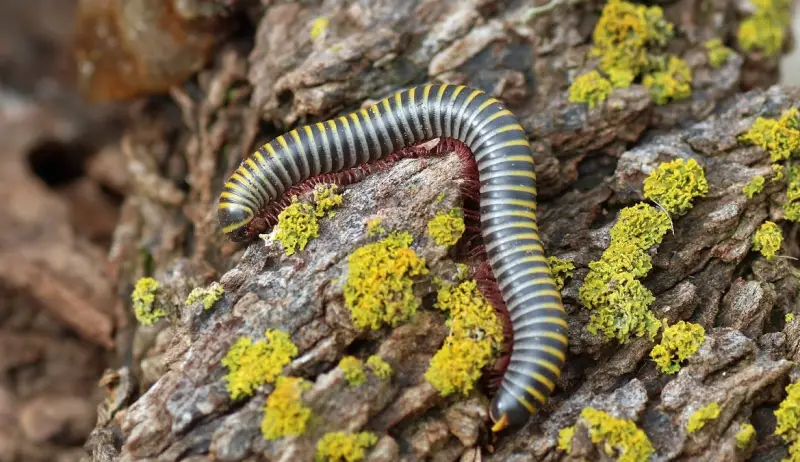
The Bumblebee Millipede (Anadenobolus monilicornis) is characterized by its mostly black body adorned with yellow bands, reflecting its name. The young millipedes are bright in color. With its numerous red legs, this species moves slowly and is gradually making its way into North America through Florida.
Native to the Caribbean, the Bumblebee Millipede thrives in areas with decaying plant matter, which it consumes for nourishment. It can be found in Central America and Florida.
Yellow-spotted Millipede
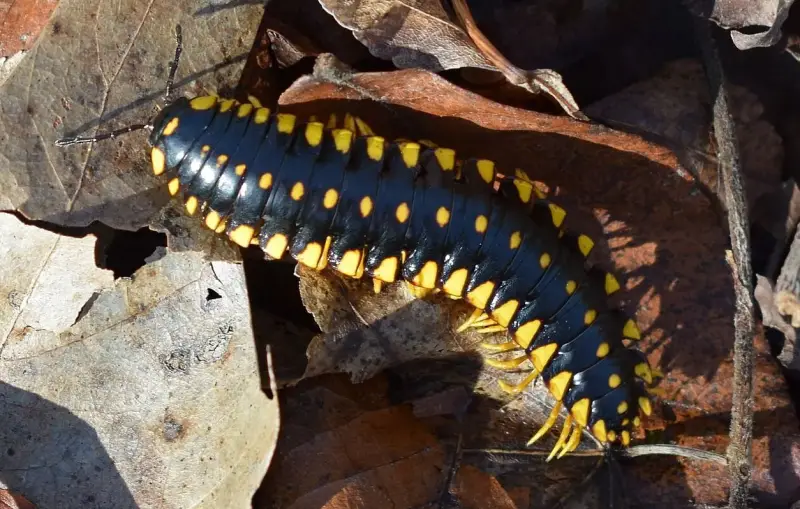
The Yellow-spotted Millipede (Harpaphe haydeniana) displays a striking contrast with its mostly black body adorned with two rows of yellow dots along the margins of its dorsum. This species feeds on decaying organic material and is commonly found in North American redwood forests.
Its juveniles also consume decomposed plant material. The Yellow-spotted Millipede can be located in Alaska, Canada, and the United States.
Eastern Lubber Grasshopper
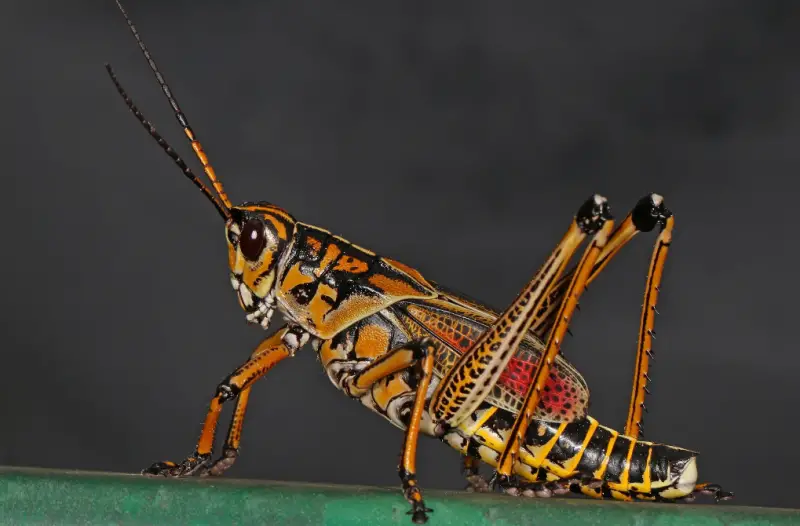
The Eastern Lubber Grasshopper (Romalea microptera) displays a range of colors across its life stages. Female adults can be orange, yellow, and black, while juveniles are primarily black and yellow.
As they grow, the young grasshoppers exhibit yellow and black markings until they molt. Juvenile Eastern Lubber Grasshoppers are characterized by a black body with dorsal yellow stripes and bands. This species can be found from Texas to Florida.
Garden Fruit Chafer
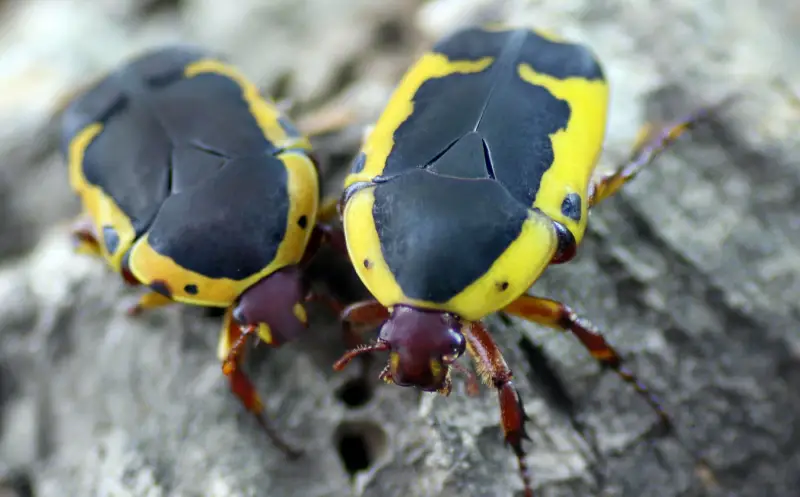
Garden Fruit Chafers (Pachnoda sinuate) are mostly black with a distinctive yellow H-shaped dorsal pattern. These pests feed on plants and fruit, and lay their eggs in dung or mud.
They are commonly found in areas with decaying plant matter. Aside from their contrasting appearance and pest status, Garden Fruit Chafers are notable for their egg-laying behavior in mud shells. They are located in South Africa and Central Africa.
Carpenter Bees
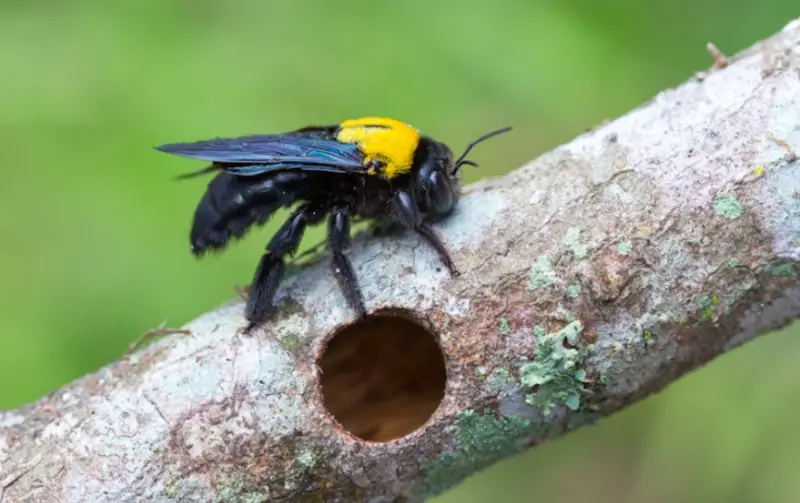
Carpenter Bees, recognized by their distinctive yellow and black stripes, play a vital role in pollination. The Eastern Carpenter Bee (Xylocopa virginica) is notable for nesting in wood, where females construct and maintain their nests. Unlike other yellow and black bees, Carpenter Bees can be identified by their smooth, hairless abdomens.
These solitary insects are found across the globe, including North America, Europe, Africa, Asia, South America, and Oceania. Despite their solitary nature, females may occasionally collaborate on nesting activities.
Honey Bees
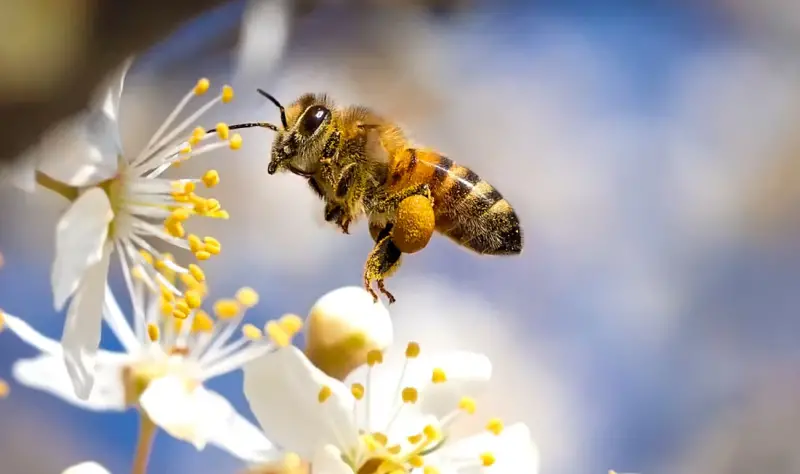
Honey Bees, with their yellow and black stripes, are essential for honey production and pollination. The Western Honey Bee (Apis mellifera) is widely recognized for creating wax-based colonies to store honey. Despite their importance, honey bee populations are declining globally.
Varieties like the Africanized Honey Bees, descendants of the European Honey Bee, are more aggressive and resilient but produce less honey. Found worldwide, these bees are critical yet sometimes dangerous, especially when they feel threatened.
Bumble Bees
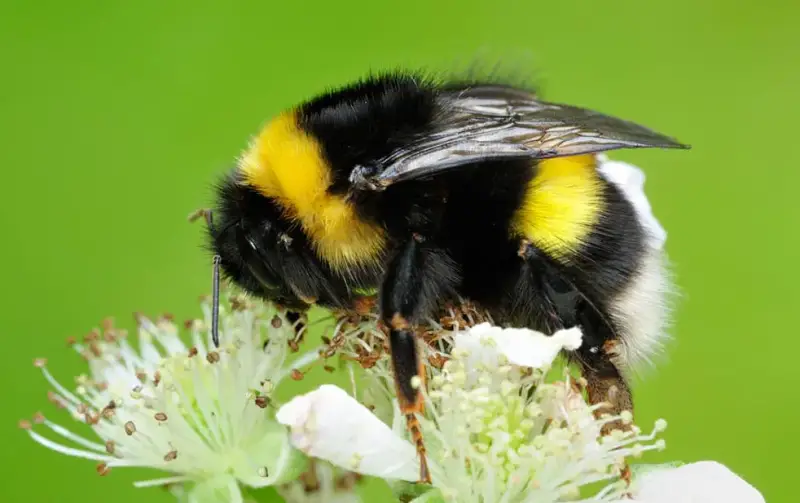
Bumble Bees, with their primarily black bodies and minimal yellow stripes, are key pollinators for crops and plants. Unlike honey bees, Bumble Bees have a furry appearance and may feature just 1-2 yellow bands, though some species like Bombus anachoreta are predominantly yellow.
These bees do not produce or store much honey and may not survive through winter. However, they excel at buzz pollination, which is particularly useful in greenhouses. Bumble Bees are found across North America, Europe, Asia, and other regions.
Yellow Jackets

Yellow Jackets, recognized by their alternating black and yellow bands, are predatory wasps that can grow up to 0.7 inches in length, especially the queens. Unlike bees, they lack the tan short hairs used for pollen collection, making them less effective pollinators.
These wasps possess stingers with potent venom, posing a significant threat to humans, particularly those with allergies. Despite their resemblance to bees, Yellow Jackets are more aggressive. They are found in North America, Europe, Oceania, and Southern Africa.
Paper Wasps

Paper Wasps, particularly the European Paper Wasp (Polistes dominula), are characterized by their black and yellow or black, brown, and yellow bodies. These wasps construct intricate nests from wood and play a crucial role in the ecosystem. While less aggressive than Yellow Jackets, they can still sting if threatened. Polistes species, common in North America, often exhibit black and yellow coloring.
These wasps contribute to environmental health, like Polistes erythrocephalus, which helps control tobacco worm outbreaks in South America. They are found across the Americas, Africa, Europe, Asia, and Australia.
Mud Dauber
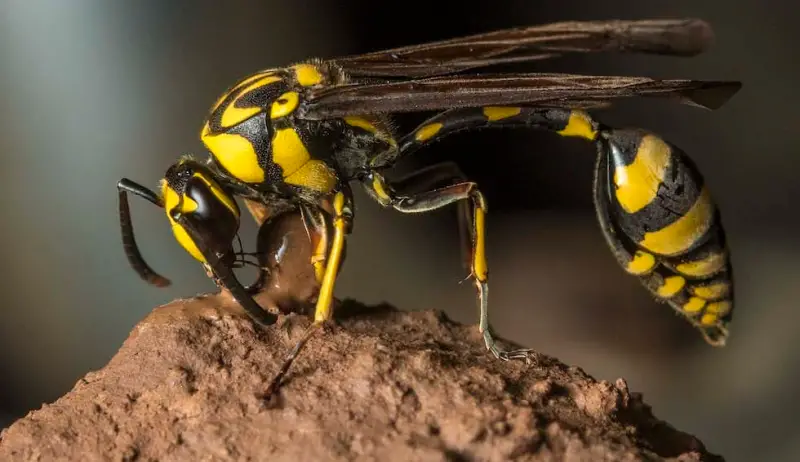
Mud Daubers, such as the Black-and-Yellow Mud Dauber (Sceliphron caementarium), are wasps known for constructing nests from mud or clay to protect their young. These wasps place their eggs on paralyzed insects within the nests, providing food for their larvae.
While often black and yellow, some Mud Daubers can be entirely black. A notable example is the Sceliphron spirifex, which has a yellow, thread-like waist and is found in Europe and Africa. Mud Daubers are widespread, inhabiting the Americas, Europe, Africa, Asia, and Oceania.


